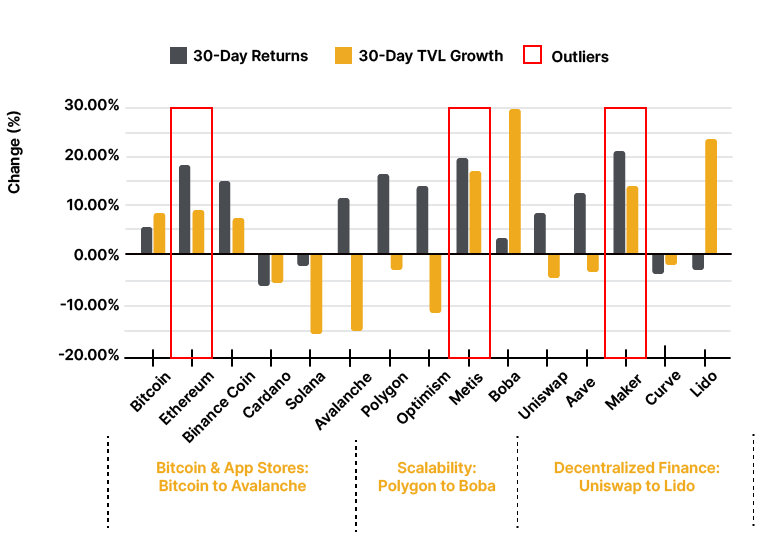A monthly review of what's happening in the crypto markets enriched with institutional research on the most important topics in the industry in cooperation with the Swiss digital asset specialist, 21Shares AG.
Markets have persevered over the past month on the back of inflation pressures sandwiched by the burgeoning war in Europe and the COVID-zero measures in China, adding flame to the fires of both crises of energy and supply. The overall cryptoasset market increased by almost 7% over the past month to rest at a little over $1T. Bitcoin (BTC) and Ethereum (ETH) increased by 5% and 18% over the past month. Other winners this month were Metis and Maker, jumping by almost 20% and 22% respectively. In the figure below the performance of the top cryptoassets within the major categories, month over month is illustrated.

Macro and Regulations
Annual inflation in the US rose by 8.2% after the country’s Consumer Price Index recorded a 0.4% increase in September. At the time of writing, CME data forecasts a 89.3% chance of a 75 basis point rate hike at the Federal Reserve’s next monetary-policy meeting on November 2. If the predictions materialize, the hike would be triple the Fed’s more typical increment of 25 basis points in prior interest-rate cycles. In quite a timely manner, right ahead of releasing the CPI data, America’s oldest bank, Bank of New York Mellon, started its endeavors with crypto holdings, becoming the first large US bank to safeguard crypto assets. In its Q3 earnings report, Tesla is revealed to be holding $218M worth of Bitcoin. Tesla’s holdings from Q2 to Q3 remain unchanged, and in its essence, this shows that institutional money still finds safety in this asset class during times of almost-recession.
While in Europe the European Council has passed a landmark crypto regulation dubbed MiCA to the parliament. If approved, the bill will be in effect as of 2024. Cryptoasset service providers (i.e., trading platforms) must make settlement transactions within 24 hours. The regulation doesn't address lending and borrowing protocols. MiCA will oversee all cryptoassets not currently regulated by existing financial services legislation. Regarding NFTs, the European Securities and Markets Authority (ESMA) will be responsible for classifying them, and only NFTs which serve as financial instruments will likely fall under MiCA's scope.
As for stablecoins, issuers will need to oblige to a significant number of authorization criteria, including a clause stating that stablecoins must be backed 1:1 by reserves that are legally and operationally segregated. USD-backed stablecoins will face some limitations when MiCA comes into effect due to efforts related to preserving the monetary sovereignty of the euro.
Crypto Infrastructure
Ethereum is fulfilling one of the key pledges of the Merge as it continues to maintain its deflationary status in its first month as a green blockchain. ETH had an impressive burn rate in the past few weeks due to the increased speculative trading activity triggered by Vitalik's light-hearted commentary that someone should create a token called "THE" as a joke.
The meme token surged by 1000% over the following days, spawning other playful meme tokens such as DIE, which also rose by roughly 5500% and expectedly crashed afterwards. What's worth pointing out here is the economic ramifications of the switch to PoS, as ETH now doesn't demand a lot of network activity to turn deflationary since the daily issuance significantly decreased. Ethereum burnt 10K ETH over the past month and is now en route to reaching pre-merge supply levels. Some other developments for other chains then ETH were:
- BNB Smart Chain was hacked by an attacker who stole 2 million BNB ($560 million) from the Binance network's cross-chain bridge, BSC Token Hub. After looking into the matter, pseudonymous researcher "samczsun" discovered a bug in how the bridge verified security proofs, allowing attackers to forge arbitrary messages.
- Solana also made headlines with the $114 million exploit of Solana’s Mango Market. The attack dragged Mango’s total value locked (TVL) down by over 20%. Later, the attacker revealed his identity, claiming to be part of a group of investors who conducted a “highly profitable trading strategy”, implying that their actions were legal.
- Avalanche NFT ecosystem gained momentum after Opensea, the leading NFT marketplace, launched native support for the Avalanche network on October 11.
- Aptos launched on mainnet on October 17. Similar to how Solana was regarded by many early on as an Ethereum contender, many market participants are speculating that Aptos could be a Solana contender.
- Optimism introduced the next evolution of Optimism’s scalability architecture: the OP Stack. The OP Stack is the first realization of the modular blockchain theory, and is the first step in an explosion of highly compatible L2s and L3s.

Decentralized Finance
Pancake Swap, the largest DEX on the BNB chain by trading volume, pushed a new governance proposal to expand to the Aptos ecosystem. The exchange – which went live on the network after a 97% approval – is now also available on Ethereum and BNB. On another front, Algorand’s TVL experienced a major boost on the back of several developments. Crypto-native VC firm Hivemind deployed $200M worth of capital into multiple DeFi protocols projects. FTX also announced their support for native USDC on Algorand, while FIFA announced its FIFA+ collect program – an Algorand-native marketplace for iconic historical moments in the form of digital collectibles (NFTs).

Uniswap, DeFi’s largest DEX by trading volume, has just passed a governance vote that will see the protocol’s deployment on zkSync. As discussed in the previous newsletter, zk-Rollups are considered the “holy grail” of scalability. Thus, Uniswap’s launch on zkSync is a significant undertaking as the DeFi ecosystem can start growing beyond Ethereum’s base chain capabilities. DEXs are the substratum that lives underneath asset management, lending, and yield-aggregation primitives, which glues together the different moving parts of DeFi.
Metaverse and NFTs

Although trading volume declined by almost 23% month over month, and 71% year over year, adoption is nevertheless on the rise, with traders increasing by 17% over the past month, marking an all-time high in October. Moreover, trademarks filed in the US for NFTs and related blockchain goods and services have doubled year over year, according to Mike Kondoudis, a USPTO licensed trademark attorney.
Formula 1 is racing towards Web3 by filing for trademarks under the name “F1” to cover cryptocurrencies, crypto marketplaces, trading and mining, and retail stores for virtual goods on the metaverse. In addition, formula 1 has a track record of supporting and promoting the crypto industry in its tournaments to the extent of getting on the regulatory radar.
Moreover, world-renowned veteran actor Sir Anthony Hopkins is partnering with Orange Comet to launch an NFT collection that randomly selects holders for a 1-1 Zoom call. Orange Comet is an NFT production and promotion company specializing in art, sports, and entertainment, bringing NFTs into Hollywood. This move inspires a plethora of use cases not only for entertainment but also for education and mentorship portals like MasterClass that are yet to utilize the technology.
The tokenization of real estate also saw adoption in October. Roofstock, a real estate platform, facilitated the sale of a South Carolina house on OpenSea for $175K. Teller Finance was also among the facilitators, joining the effort as a lender. While being sold on a decentralized ledger brings about the perks of lower transactional costs and more, tokenization of real estate is being battle-tested, arguably at the best time for battle tests, under many horizons such as demand and regulatory approval.




